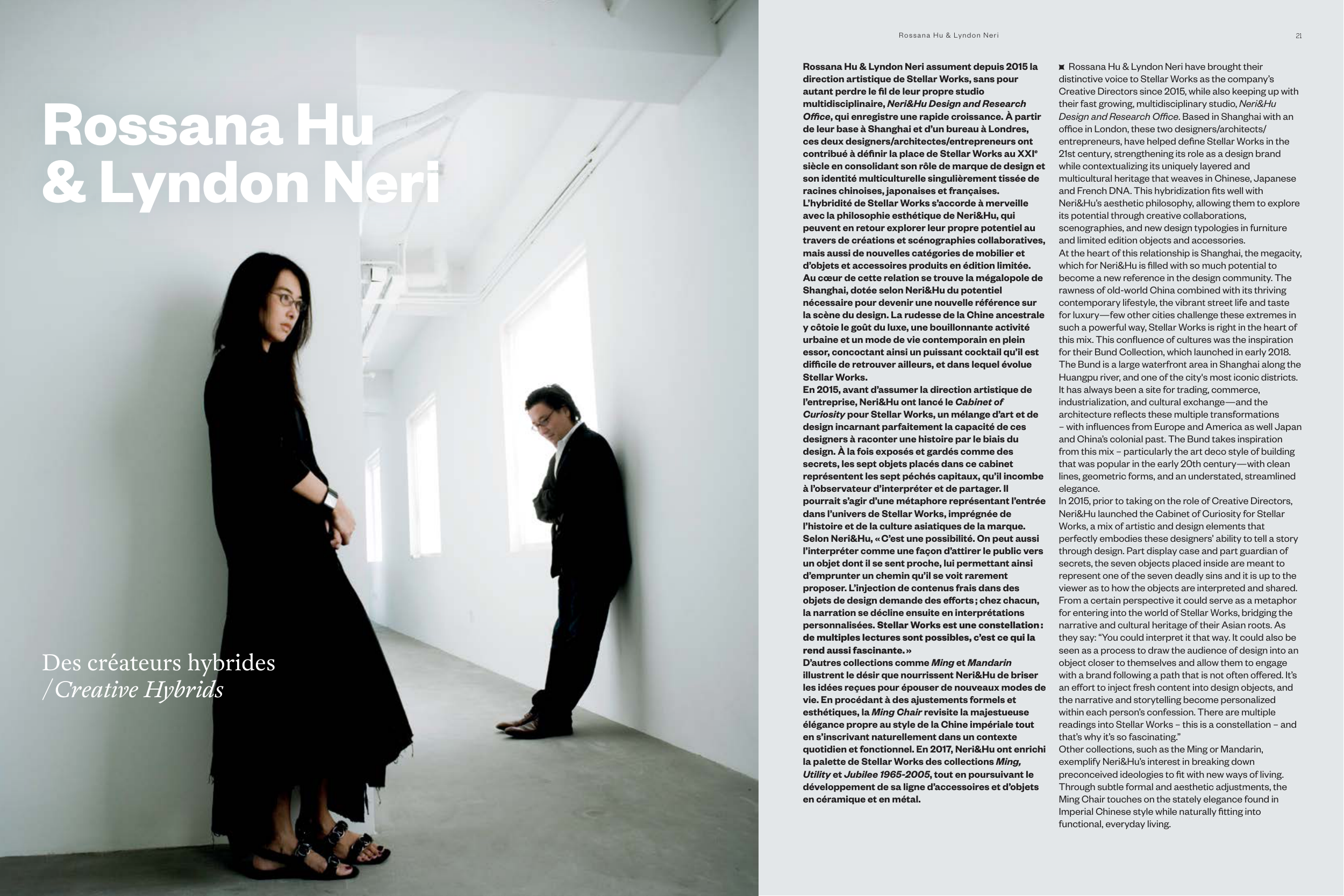20
21
STORYTELLING
Rossana Hu & Lyndon Neri
Rossana Hu & Lyndon Neri
Des créateurs hybrides
/Creative Hybrids
Rossana Hu
& Lyndon Neri
Rossana Hu & Lyndon Neri assument depuis 2015 la
direction artistique de Stellar Works, sans pour
autant perdre le fil de leur propre studio
multidisciplinaire, Neri&Hu Design and Research
Office, qui enregistre une rapide croissance. À partir
de leur base à Shanghai et d’un bureau à Londres,
ces deux designers/architectes/entrepreneurs ont
contribué à définir la place de Stellar Works au XXIe
siècle en consolidant son rôle de marque de design et
son identité multiculturelle singulièrement tissée de
racines chinoises, japonaises et françaises.
L’hybridité de Stellar Works s’accorde à merveille
avec la philosophie esthétique de Neri&Hu, qui
peuvent en retour explorer leur propre potentiel au
travers de créations et scénographies collaboratives,
mais aussi de nouvelles catégories de mobilier et
d’objets et accessoires produits en édition limitée.
Au cœur de cette relation se trouve la mégalopole de
Shanghai, dotée selon Neri&Hu du potentiel
nécessaire pour devenir une nouvelle référence sur
la scène du design. La rudesse de la Chine ancestrale
y côtoie le goût du luxe, une bouillonnante activité
urbaine et un mode de vie contemporain en plein
essor, concoctant ainsi un puissant cocktail qu’il est
difficile de retrouver ailleurs, et dans lequel évolue
Stellar Works.
En 2015, avant d’assumer la direction artistique de
l’entreprise, Neri&Hu ont lancé le Cabinet of
Curiosity pour Stellar Works, un mélange d’art et de
design incarnant parfaitement la capacité de ces
designers à raconter une histoire par le biais du
design. À la fois exposés et gardés comme des
secrets, les sept objets placés dans ce cabinet
représentent les sept péchés capitaux, qu’il incombe
à l’observateur d’interpréter et de partager. Il
pourrait s’agir d’une métaphore représentant l’entrée
dans l’univers de Stellar Works, imprégnée de
l’histoire et de la culture asiatiques de la marque.
Selon Neri&Hu, « C’est une possibilité. On peut aussi
l’interpréter comme une façon d’attirer le public vers
un objet dont il se sent proche, lui permettant ainsi
d’emprunter un chemin qu’il se voit rarement
proposer. L’injection de contenus frais dans des
objets de design demande des efforts ; chez chacun,
la narration se décline ensuite en interprétations
personnalisées. Stellar Works est une constellation :
de multiples lectures sont possibles, c’est ce qui la
rend aussi fascinante. »
D’autres collections comme Ming et Mandarin
illustrent le désir que nourrissent Neri&Hu de briser
les idées reçues pour épouser de nouveaux modes de
vie. En procédant à des ajustements formels et
esthétiques, la Ming Chair revisite la majestueuse
élégance propre au style de la Chine impériale tout
en s’inscrivant naturellement dans un contexte
quotidien et fonctionnel. En 2017, Neri&Hu ont enrichi
la palette de Stellar Works des collections Ming,
Utility et Jubilee 1965-2005, tout en poursuivant le
développement de sa ligne d’accessoires et d’objets
en céramique et en métal.
Rossana Hu & Lyndon Neri have brought their
distinctive voice to Stellar Works as the company’s
Creative Directors since 2015, while also keeping up with
their fast growing, multidisciplinary studio, Neri&Hu
Design and Research Office. Based in Shanghai with an
office in London, these two designers/architects/
entrepreneurs, have helped define Stellar Works in the
21st century, strengthening its role as a design brand
while contextualizing its uniquely layered and
multicultural heritage that weaves in Chinese, Japanese
and French DNA. This hybridization fits well with
Neri&Hu’s aesthetic philosophy, allowing them to explore
its potential through creative collaborations,
scenographies, and new design typologies in furniture
and limited edition objects and accessories.
At the heart of this relationship is Shanghai, the megacity,
which for Neri&Hu is filled with so much potential to
become a new reference in the design community. The
rawness of old-world China combined with its thriving
contemporary lifestyle, the vibrant street life and taste
for luxury—few other cities challenge these extremes in
such a powerful way, Stellar Works is right in the heart of
this mix. This confluence of cultures was the inspiration
for their Bund Collection, which launched in early 2018.
The Bund is a large waterfront area in Shanghai along the
Huangpu river, and one of the city's most iconic districts.
It has always been a site for trading, commerce,
industrialization, and cultural exchange—and the
architecture reflects these multiple transformations
– with influences from Europe and America as well Japan
and China’s colonial past. The Bund takes inspiration
from this mix – particularly the art deco style of building
that was popular in the early 20th century—with clean
lines, geometric forms, and an understated, streamlined
elegance.
In 2015, prior to taking on the role of Creative Directors,
Neri&Hu launched the Cabinet of Curiosity for Stellar
Works, a mix of artistic and design elements that
perfectly embodies these designers’ ability to tell a story
through design. Part display case and part guardian of
secrets, the seven objects placed inside are meant to
represent one of the seven deadly sins and it is up to the
viewer as to how the objects are interpreted and shared.
From a certain perspective it could serve as a metaphor
for entering into the world of Stellar Works, bridging the
narrative and cultural heritage of their Asian roots. As
they say: “You could interpret it that way. It could also be
seen as a process to draw the audience of design into an
object closer to themselves and allow them to engage
with a brand following a path that is not often offered. It’s
an effort to inject fresh content into design objects, and
the narrative and storytelling become personalized
within each person’s confession. There are multiple
readings into Stellar Works – this is a constellation – and
that’s why it’s so fascinating.”
Other collections, such as the Ming or Mandarin,
exemplify Neri&Hu’s interest in breaking down
preconceived ideologies to fit with new ways of living.
Through subtle formal and aesthetic adjustments, the
Ming Chair touches on the stately elegance found in
Imperial Chinese style while naturally fitting into
functional, everyday living.


